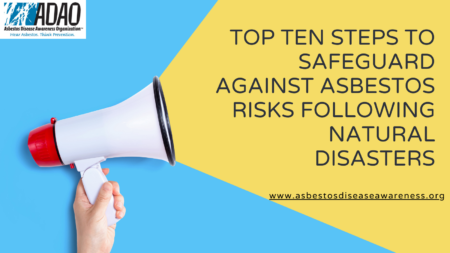Posted on August 15, 2023

Asbestos is a known human carcinogen and there is no safe level of asbestos exposure.
Asbestos exposure following a natural disaster is a significant concern, particularly in regions with older structures that can contain asbestos-containing materials (ACMs). The devastation of such events can cause asbestos fibers to become airborne, posing serious health risks. Recognizing and mitigating these risks is crucial in ensuring safety during recovery.
Asbestos can be found in a variety of materials, including:
- Insulation: Used for heat resistance and insulation in buildings and industrial settings.
- Floor Tiles: Asbestos was often used in vinyl tiles due to its durability.
- Cementitious, Roofing and Siding Shingles: Used for their fireproof qualities.
- Asphaltic roofing materials, especially on commercial buildings.
- Textured Ceiling Treatments, and Patching Compounds: Used on walls and ceilings.
- Walls and Floors: Used around wood-burning stoves because of its fireproof nature.
- Hot Water and Steam Pipes: Often insulated with an asbestos blanket or tape.
- Oil and Coal Furnaces: Often with asbestos insulation.
- Automotive Parts: Like brake pads and linings, clutch facings, and gaskets.
When these materials deteriorate or are disturbed (e.g., during renovations, demolitions, or maintenance activities), asbestos fibers can be released into the air, posing health risks to those who inhale them. Asbestos is a concern because many buildings, infrastructures, and older products still contain it, and proper measures need to be taken to handle and eventually remove these materials to prevent asbestos exposure.
Here’s a guide to minimize or prevent asbestos exposure post-disaster:
- Stay Informed: Regularly update yourself with reports from local health departments, emergency services, and environmental agencies about asbestos hazards in affected zones. Adhere to guidelines and regulations set by the Environmental Protection Agency (EPA, https://www.epa.gov/asbestos ), Federal Emergency Management Agency (FEMA ,https://www.fema.gov/ ), and the Occupational Safety and Health Administration (OSHA, https://www.osha.gov/asbestos).
Note: OSHA asbestos page “construction” applies to removal and clean-up activities)
- Seek Expert Help: If you suspect asbestos contamination on your property, promptly engage an asbestos professional. Such specialists can conduct asbestos tests, evaluate risks, and guide further action.
- Avoid Damaged Buildings: Refrain from entering damaged structures, particularly older ones. Disruptions may release asbestos fibers. Many other safety hazards can also be encountered.
- Personal Protection and Decontamination
- Familiarize yourself with the correct procedures to wear, use, and dispose of Personal Protective Equipment (PPE).
- Use masks with suitable filtration, preferably N95 respirators or better.
- Wear protective outer clothing and gloves that can be removed and discarded.
- Wash exposed parts of the body with soap and water. Avoid carrying asbestos fibers out of a worksite where they can later be inhaled by others (e.g., by family members at home).
- Limit Dust Generation: If you need to be in affected areas, wet the debris to curb dust. Clean with wet rags or mops and dispose of them properly afterward.
- Avoid Sweeping or Vacuuming: These actions can render asbestos airborne.
- Proper Waste Disposal: Dispose of potential asbestos-containing debris in sealed, leak-proof containers. Abide by local guidelines for the appropriate disposal of asbestos waste.
- Isolate the Area: If an area is suspected to have asbestos, restrict its access. Utilize barriers, barrier tape, or cones to demarcate the zone.
- Renovation & Demolition: For damaged asbestos-containing facilities, enlist a licensed asbestos removal contractor for repairs or demolition. They possess the required skills, state licensing, and tools to handle such hazards.
- Educate Others: If you’re in a leadership or influential role, disseminate this knowledge among peers, neighbors, and family to maintain communal safety.
In the United States, the use of asbestos in many products was significantly reduced by the late 1970s and 1980s due to increasing awareness of the health risks associated with asbestos exposure. However, asbestos use was never fully banned. In 1989, the Environmental Protection Agency (EPA) issued a rule under the Toxic Substances Control Act (TSCA) to ban most asbestos-containing products. However, in 1991, this rule was largely vacated by the Fifth Circuit Court of Appeals, allowing asbestos imports and use to continue.
Education saves lives.
Linda Reinstein
